An Innovative Concept for a Multivariate Plausibility Assessment of Simultaneously Recorded Data
Simple Summary
Abstract
1. Introduction
2. Materials and Methods
2.1. Ethical Declaration
2.2. Data Recording
2.2.1. Farms and Animals
2.2.2. Climate Data
2.2.3. Intra-Reticular pH and Temperature
2.2.4. Eating, Chewing and Locomotion Behavior
2.2.5. Milk Yield and Milk Samples
2.2.6. Blood Samples
2.3. Data Preparation
2.3.1. Unification of the Temporal Resolution
2.3.2. Handling Missing Values
2.3.3. Transformations
2.4. Multivariate Plausibility Assessment
2.4.1. Concept and Underlying Assumptions
- Several of the measured traits are (physiologically) associated
- Cases of disease are reflected in more than one of the measured parameters in form of conspicuously high or low values
- The probability that two or more measuring systems will display erroneous values at the same time is close to zero
- Case A represents a healthy and thus physiologically normal animal,
- Case B is a cow, whose reticular pH sensor had a malfunction with pH as Trait I,
- Case C is a cow with a temporarily dropped halter with daily rumination duration as Trait II, and
- Case D shows a cow with a clinical mastitis, where Trait I would be the milk performance, Trait II the SCC or body temperature and Trait III the daily eating or rumination duration.
2.4.2. Selection of Traits
2.4.3. Technical Implementation of the MPA
- Neither the animal effect nor the residuals within the animal are extreme,
- The animal effects are extreme, but not the residuals within the animal,
- The residuals within one animal are extreme, but not the animal effect,
- Both the animal effect and the residuals within the animal are extreme.
3. Results and Discussion
3.1. Classification of Observations and Descriptive Statistics
3.2. Case Studies
3.3. Further Remarks and Implications for Future Research
3.4. Limitations of the Study
4. Conclusions
Author Contributions
Funding
Acknowledgments
Conflicts of Interest
Appendix A
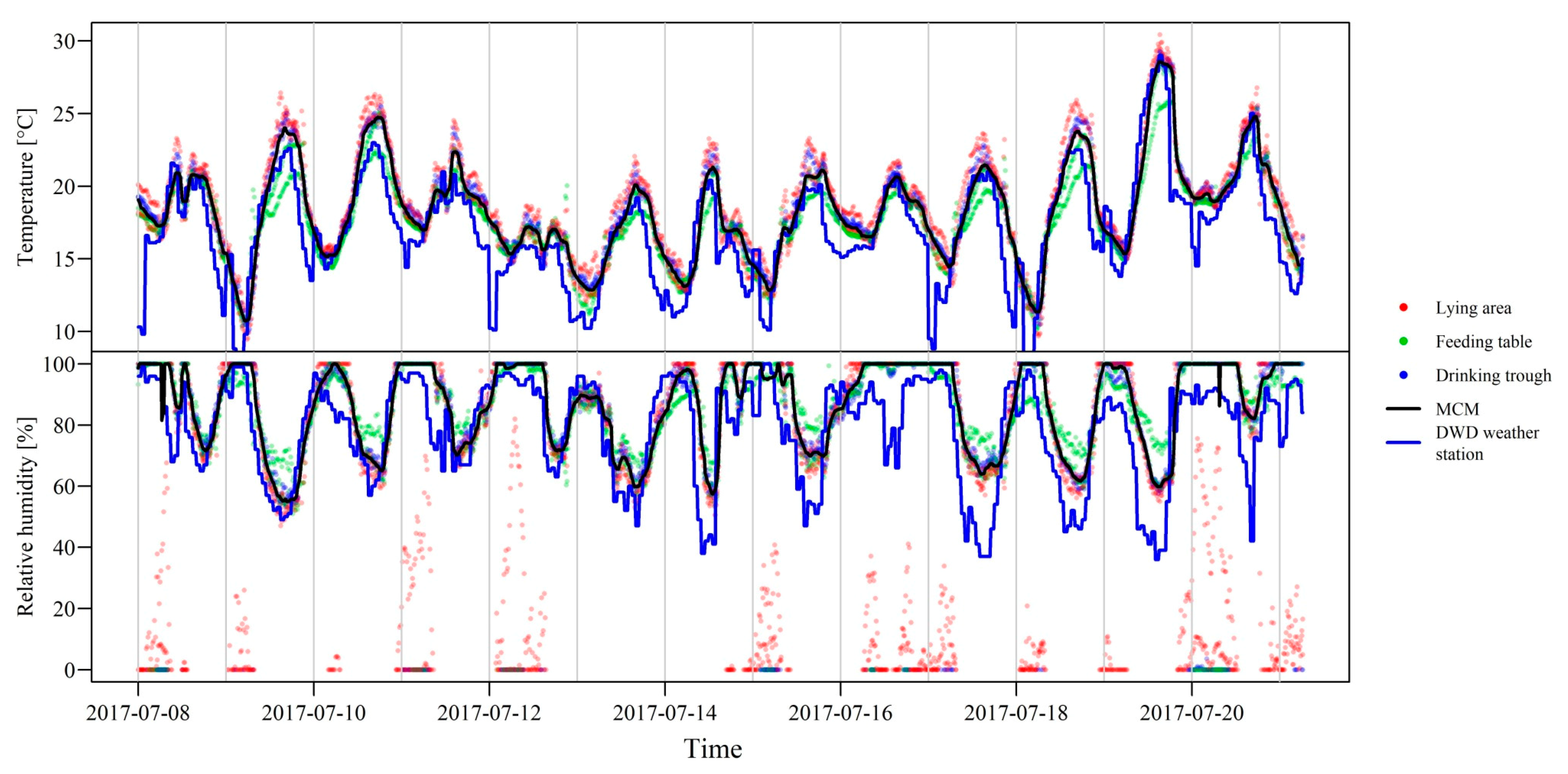
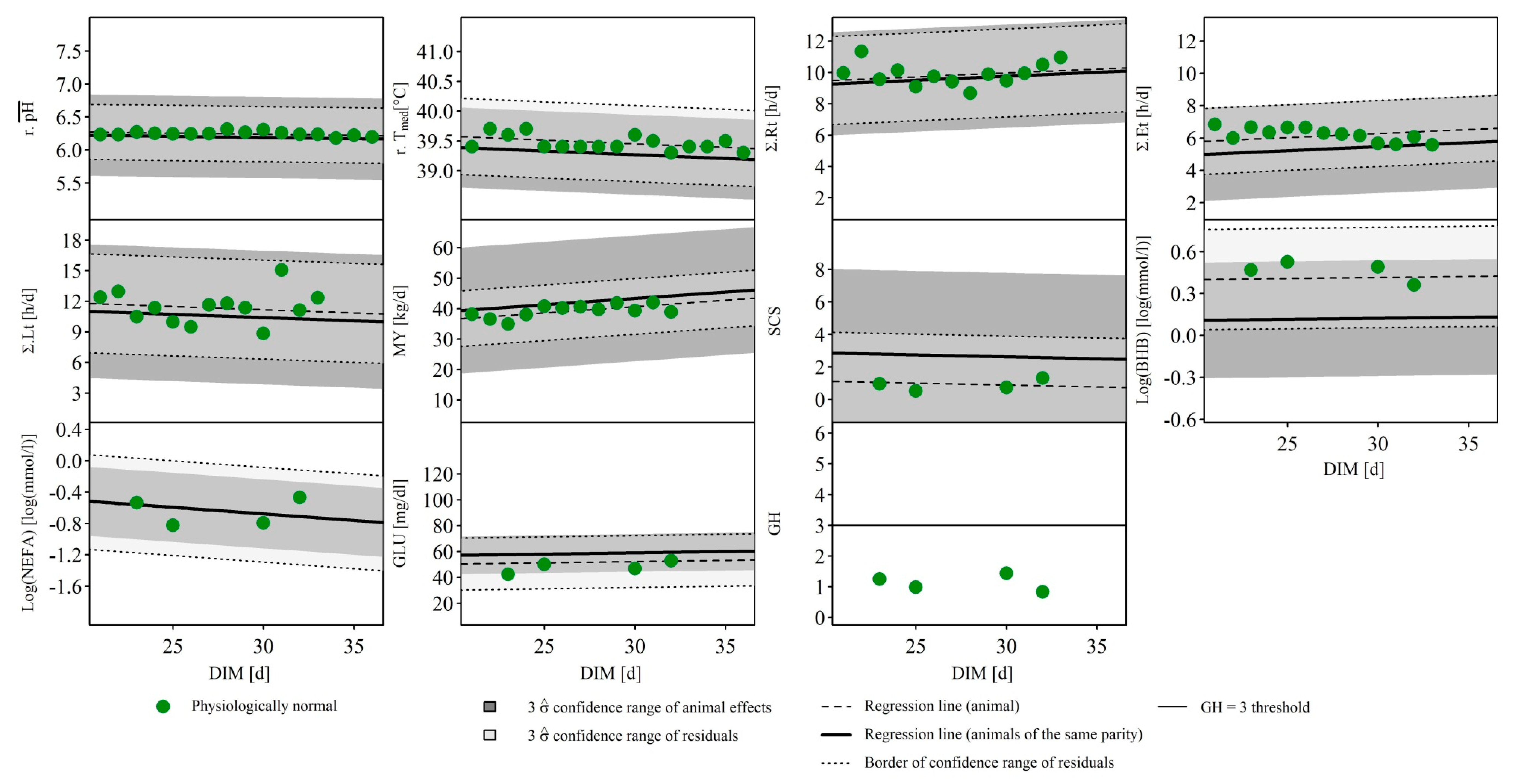
References
- Fogsgaard, K.K.; Røntved, C.M.; Sørensen, P.; Herskin, M.S. Sickness behavior in dairy cows during Escherichia coli mastitis. J. Dairy Sci. 2012, 95, 630–638. [Google Scholar] [CrossRef] [PubMed]
- Baird, G.D. Primary ketosis in the high-producing dairy cow: Clinical and subclinical disorders, treatment, prevention, and outlook. J. Dairy Sci. 1982, 65, 1–10. [Google Scholar] [CrossRef]
- Pavlenko, A.; Bergsten, C.; Ekesbo, I.; Kaart, T.; Aland, A.; Lidfors, L. Influence of digital dermatitis and sole ulcer on dairy cow behaviour and milk production. Animal 2011, 5, 1259–1269. [Google Scholar] [CrossRef] [PubMed]
- Fleischer, P.; Metzner, M.; Beyerbach, M.; Hoedemaker, M.; Klee, W. The relationship between milk yield and the incidence of some diseases in dairy cows. J. Dairy Sci. 2001, 84, 2025–2035. [Google Scholar] [CrossRef]
- Wiggans, G.R.; VanRaden, P.M.; Philpot, J.C. Technical note: Detection and adjustment of abnormal test-day yields. J. Dairy Sci. 2003, 86, 2721–2724. [Google Scholar] [CrossRef]
- Gao, H.; Madsen, P.; Pösö, J.; Aamand, G.P.; Lidauer, M.; Jensen, J. Short communication: Multivariate outlier detection for routine Nordic dairy cattle genetic evaluation in the Nordic Holstein and Red population. J. Dairy Sci. 2018, 101, 11159–11164. [Google Scholar] [CrossRef]
- Eissen, J.J.; Kanis, E.; Merks, J.W.M. Algorithms for identifying errors in individual feed intake data of growing pigs in group-housing. Appl. Eng. Agric. 1998, 14, 667–673. [Google Scholar] [CrossRef]
- Villot, C.; Meunier, B.; Bodin, J.; Martin, C.; Silberberg, M. Relative reticulo-rumen pH indicators for subacute ruminal acidosis detection in dairy cows. Animal 2017, 12, 481–490. [Google Scholar] [CrossRef]
- Alawneh, J.I.; Stevenson, M.A.; Williamson, N.B.; Lopez-Villalobos, N.; Otley, T. Automatic recording of daily walkover liveweight of dairy cattle at pasture in the first 100 days in milk. J. Dairy Sci. 2011, 94, 4431–4440. [Google Scholar] [CrossRef]
- Liang, D.; Wood, C.L.; McQuerry, K.J.; Ray, D.L.; Clark, J.D.; Bewley, J.M. Influence of breed, milk production, season, and ambient temperature on dairy cow reticulorumen temperature. J. Dairy Sci. 2013, 96, 5072–5081. [Google Scholar] [CrossRef]
- Shenk, J.S.; Westerhaus, M.O. Population definition, sample selection, and calibration procedures for near infrared reflectance spectroscopy. Crop. Sci. 1991, 31, 469–474. [Google Scholar] [CrossRef]
- Vanlierde, A.; Vanrobays, M.L.; Dehareng, F.; Froidmont, E.; Soyeurt, H.; McParland, S.; Lewis, E.; Deighton, M.H.; Grandl, F.; Kreuzer, M.; et al. Hot topic: Innovative lactation-stage-dependent prediction of methane emissions from milk mid-infrared spectra. J. Dairy Sci. 2015, 98, 5740–5747. [Google Scholar] [CrossRef] [PubMed]
- Stevens, J.P. Outliers and influential data points in regression analysis. Psychol. Bull. 1984, 95, 334–344. [Google Scholar] [CrossRef]
- Rousseeuw, P.J.; Debruyne, M.; Engelen, S.; Hubert, M. Robustness and outlier detection in chemometrics. Crit. Rev. Anal. Chem. 2006, 36, 221–242. [Google Scholar] [CrossRef]
- DWD Climate Data Center (CDC): Historical Hourly Station Observations of 2 m Air Temperature and Humidity for Germany, Version v006. 2018. Available online: https://opendata.dwd.de/test/CDC/observations_germany/climate/hourly/air_temperature/historical/DESCRIPTION_obsgermany_climate_hourly_tu_historical_en.pdf (accessed on 25 October 2019).
- ICAR Section 2—Guidelines for Dairy Cattle Milk Recording. Available online: https://www.icar.org/Guidelines/02-Overview-Cattle-Milk-Recording.pdf (accessed on 14 March 2020).
- Grelet, C.; Fernández Pierna, J.A.; Dardenne, P.; Baeten, V.; Dehareng, F. Standardization of milk mid-infrared spectra from a European dairy network. J. Dairy Sci. 2015, 98, 2150–2160. [Google Scholar] [CrossRef]
- Gengler, N.; Soyeurt, H.; Dehareng, F.; Bastin, C.; Colinet, F.; Hammami, H.; Vanrobays, M.-L.; Lainé, A.; Vanderick, S.; Grelet, C.; et al. Capitalizing on fine milk composition for breeding and management of dairy cows. J. Dairy Sci. 2016, 99, 4071–4079. [Google Scholar] [CrossRef]
- Quist, M.A.; LeBlanc, S.J.; Hand, K.J.; Lazenby, D.; Miglior, F.; Kelton, D.F. Milking-to-milking variability for milk yield, fat and protein percentage, and somatic cell count. J. Dairy Sci. 2008, 91, 3412–3423. [Google Scholar] [CrossRef]
- Wiggans, G.R.; Shook, G.E. A lactation measure of somatic cell count. J. Dairy Sci. 1987, 70, 2666–2672. [Google Scholar] [CrossRef]
- Kadzere, C.T.; Murphy, M.R.; Silanikove, N.; Maltz, E. Heat stress in lactating dairy cows: A review. Livest. Prod. Sci. 2002, 77, 59–91. [Google Scholar] [CrossRef]
- Soyeurt, H.; Froidmont, E.; Dufrasne, I.; Hailemariam, D.; Wang, Z.; Bertozzi, C.; Colinet, F.G.; Dehareng, F.; Gengler, N. Contribution of milk mid-infrared spectrum to improve the accuracy of test-day body weight predicted from stage, lactation number, month of test and milk yield. Livest. Sci. 2019, 227, 82–89. [Google Scholar] [CrossRef]
- R Core Team. R: A Language and Environment for Statistical Computing, Version 3.6.2; R Foundation for Statistical Computing: Vienna, Austria, 2019. [Google Scholar]
- yWorks GmbH. yEd Graph Editor, Version 3.17.2; yWorks GmbH: Tübingen, Germany, 2019. [Google Scholar]
- Bates, D.; Maechler, M.; Bolker, B.; Walker, S. Fitting linear mixed-effects models using lme4. J. Stat. Softw. 2015, 67, 1–48. [Google Scholar] [CrossRef]
- Grelet, C.; Vanlierde, A.; Hostens, M.; Foldager, L.; Salavati, M.; Ingvartsen, K.L.; Crowe, M.; Sorensen, M.T.; Froidmont, E.; Ferris, C.P.; et al. Potential of milk mid-IR spectra to predict metabolic status of cows through blood components and an innovative clustering approach. Animal 2019, 13, 649–658. [Google Scholar] [CrossRef] [PubMed]
- Colman, E.; Fokkink, W.B.; Craninx, M.; Newbold, J.R.; De Baets, B.; Fievez, V. Effect of induction of subacute ruminal acidosis on milk fat profile and rumen parameters. J. Dairy Sci. 2010, 93, 4759–4773. [Google Scholar] [CrossRef] [PubMed]
- Dado, R.G.; Allen, M.S. Intake limitations, feeding behavior, and rumen function of cows challenged with rumen fill from dietary fiber or inert bulk. J. Dairy Sci. 1995, 78, 118–133. [Google Scholar] [CrossRef]
- Denwood, M.J.; Kleen, J.L.; Jensen, D.B.; Jonsson, N.N. Describing temporal variation in reticuloruminal pH using continuous monitoring data. J. Dairy Sci. 2018, 101, 233–245. [Google Scholar] [CrossRef]
- Van Hertem, T.; Maltz, E.; Antler, A.; Romanini, C.E.B.; Viazzi, S.; Bahr, C.; Schlageter-Tello, A.; Lokhorst, C.; Berckmans, D.; Halachmi, I. Lameness detection based on multivariate continuous sensing of milk yield, rumination, and neck activity. J. Dairy Sci. 2013, 96, 4286–4298. [Google Scholar] [CrossRef]
- Shewhart, W.A. Economic Control of Quality of Manufactured Product, 7th ed.; D. Van Nostrand Reinhold, Inc.: New York, NY, USA, 1931. [Google Scholar]
- De Mol, R.M.; Ouweltjes, W. Detection model for mastitis in cows milked in an automatic milking system. Prev. Vet. Med. 2001, 49, 71–82. [Google Scholar] [CrossRef]
- Jacobs, J.A.; Siegford, J.M. Invited review: The impact of automatic milking systems on dairy cow management, behavior, health, and welfare. J. Dairy Sci. 2012, 95, 2227–2247. [Google Scholar] [CrossRef]
- Schmitz, R.; Schnabel, K.; von Soosten, D.; Meyer, U.; Spiekers, H.; Rehage, J.; Dänicke, S. The effects of energy concentration in roughage and allowance of concentrates on performance, health and energy efficiency of pluriparous dairy cows during early lactation. Arch. Anim. Nutr. 2018, 72, 100–120. [Google Scholar] [CrossRef]
- Buttchereit, N.; Stamer, E.; Junge, W.; Thaller, G. Evaluation of five lactation curve models fitted for fat: Protein ratio of milk and daily energy balance. J. Dairy Sci. 2010, 93, 1702–1712. [Google Scholar] [CrossRef]
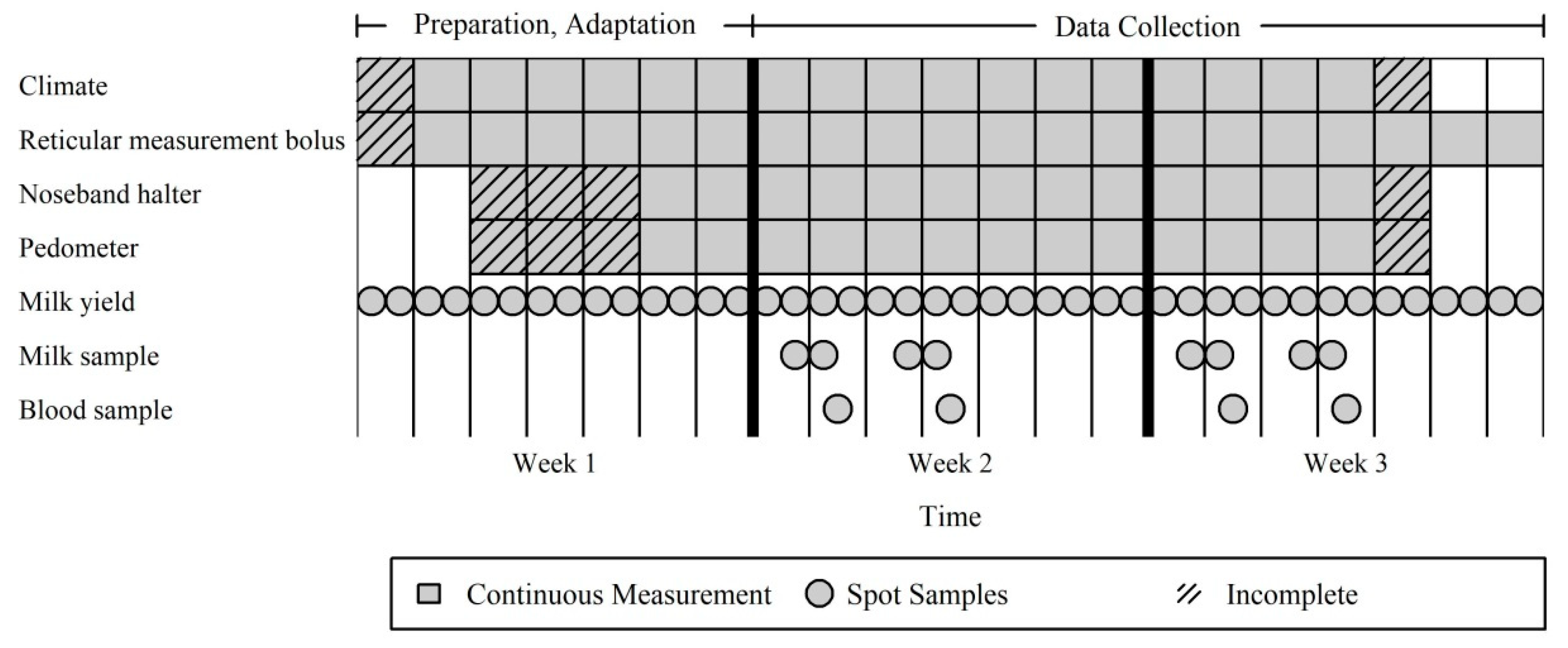

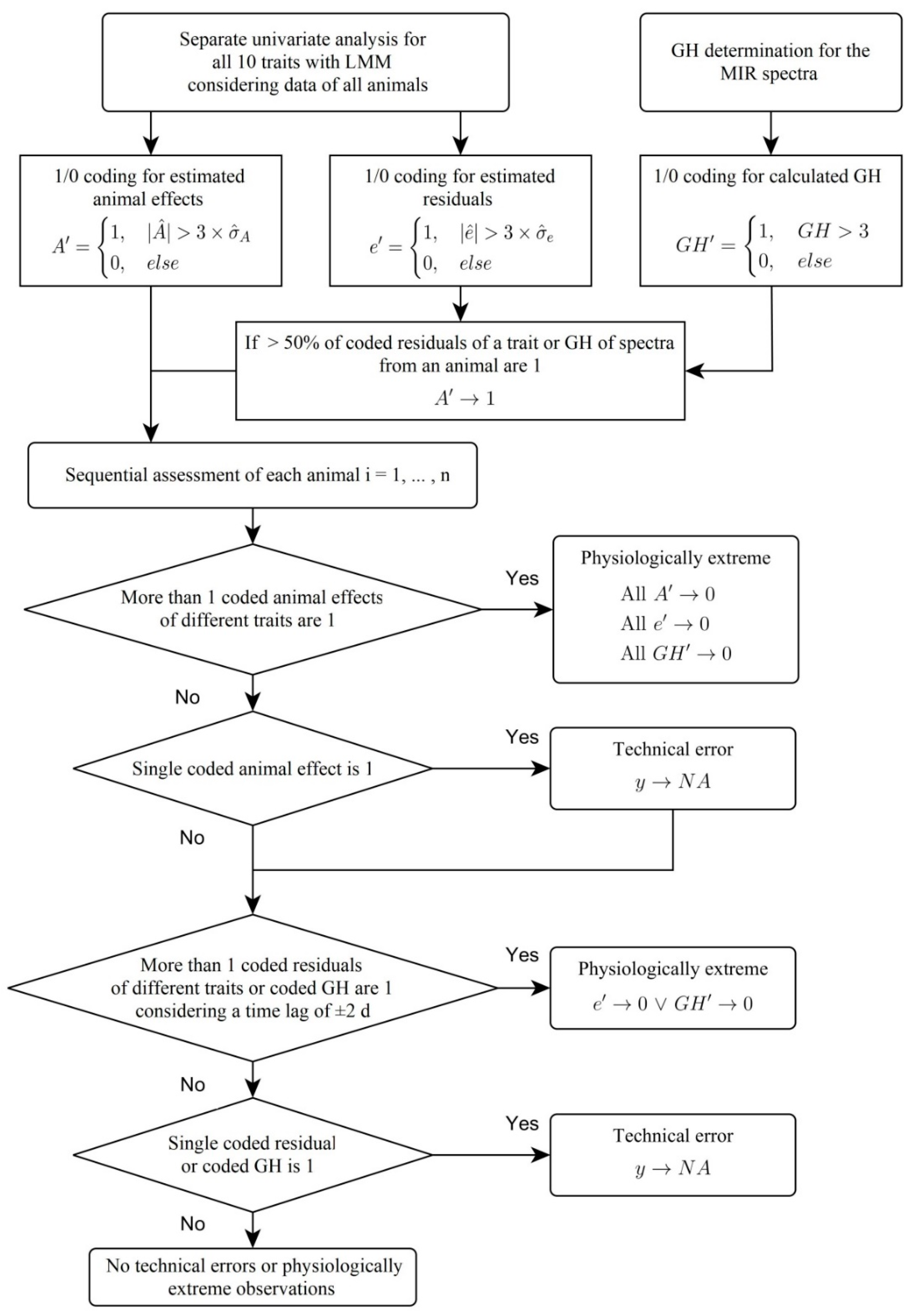

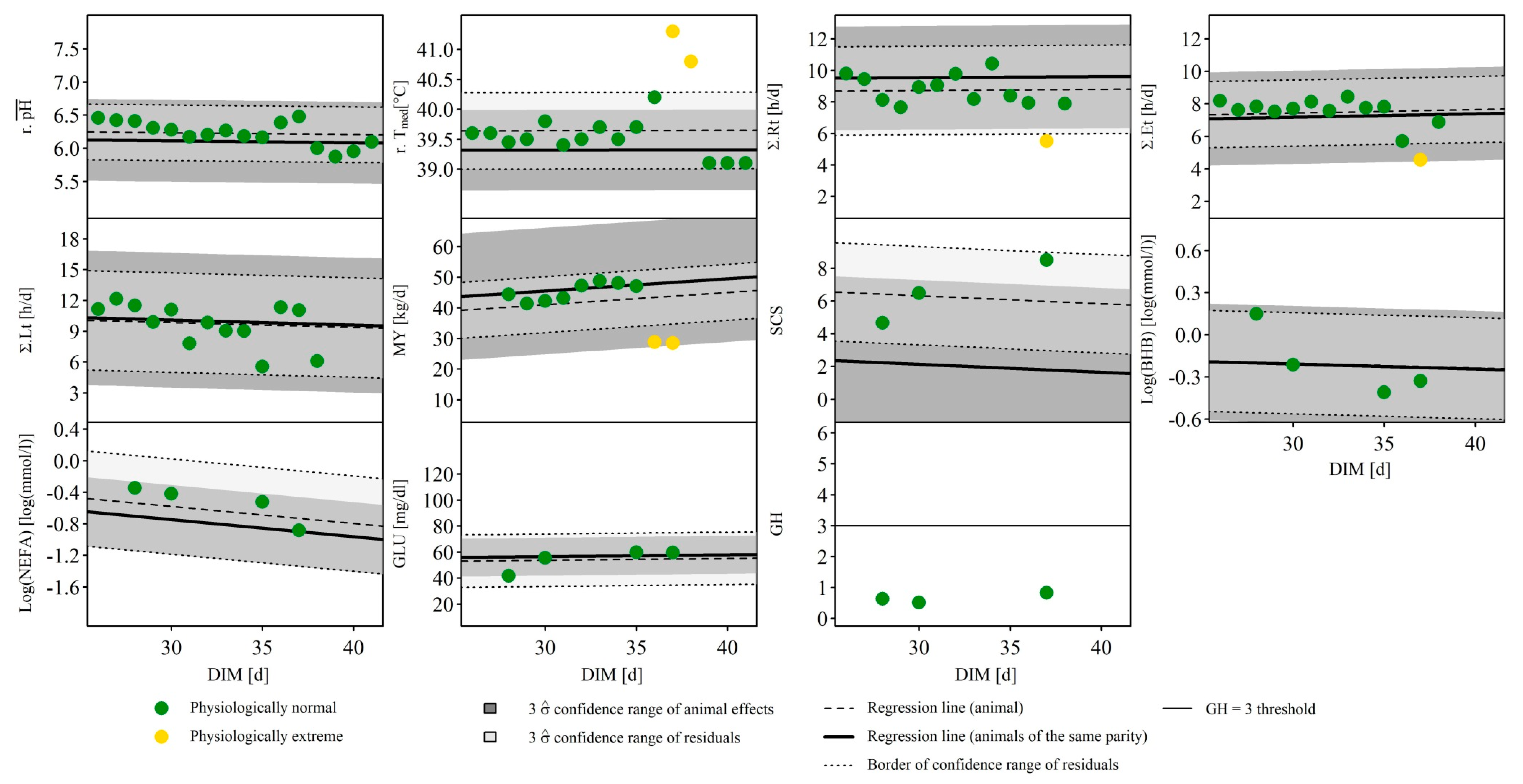
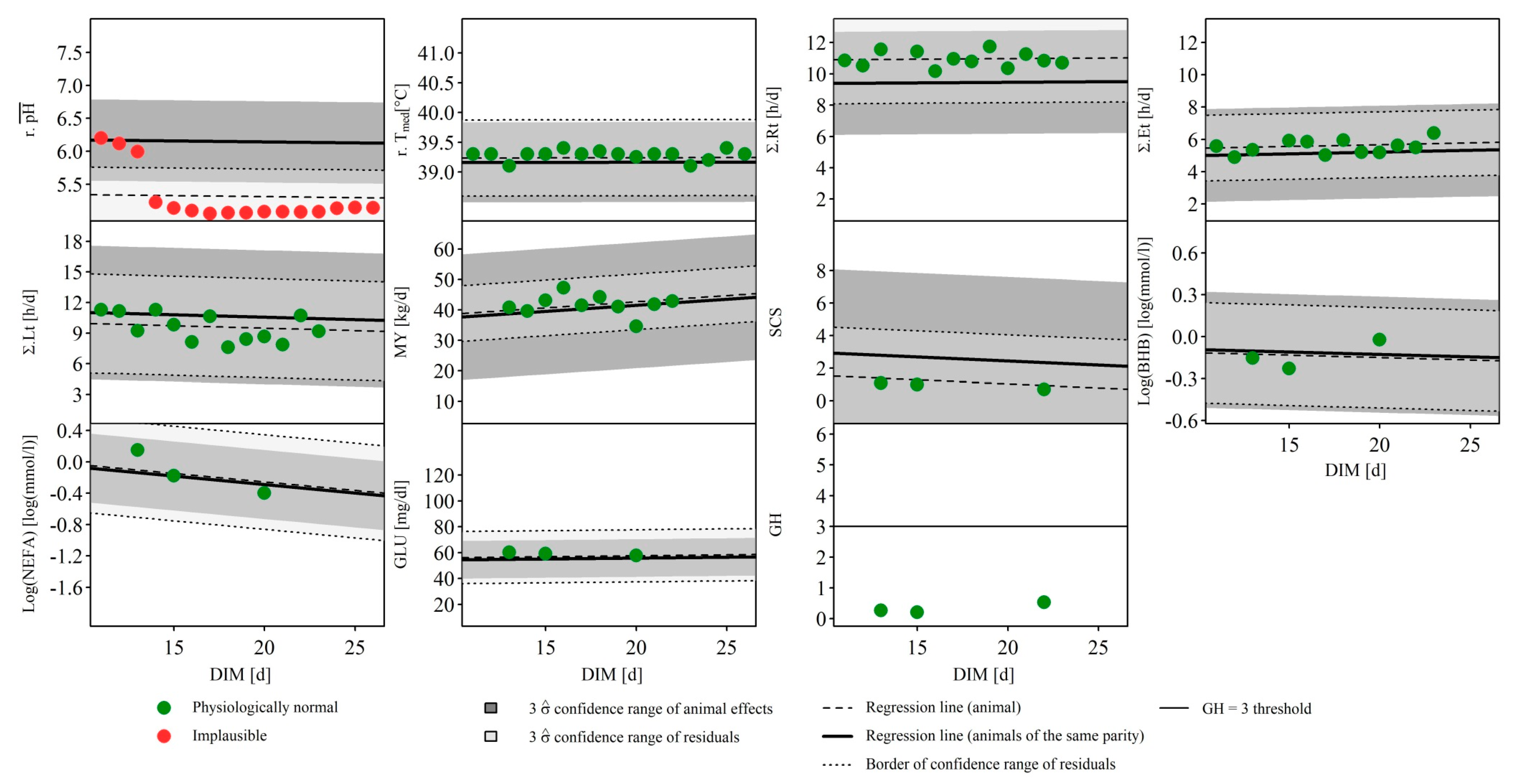
| Variable | Before MPA | After MPA | ||||||||||||
|---|---|---|---|---|---|---|---|---|---|---|---|---|---|---|
| nA | n | Mean | SD | Min | Median | Max | nA | n | Mean | SD | Min | Median | Max | |
| Climate | ||||||||||||||
| Daily Mean Temperature (s.T), °C | 160 | 12.1 | 6.2 | −1.3 | 12.8 | 25.0 | 160 | 12.1 | 6.2 | −1.3 | 12.8 | 25.0 | ||
| Animal | ||||||||||||||
| Lactation stage (DIM), d | 100 | 1600 | 20.1 | 7.5 | 3 | 20 | 41 | 100 | 1600 | 20.1 | 7.5 | 3 | 20 | 41 |
| Parity | 100 | 1600 | 3.1 | 1.6 | 1 | 3 | 8 | 100 | 1600 | 3.1 | 1.6 | 1 | 3 | 8 |
| Reticular measurement bolus | ||||||||||||||
| Daily mean pH (r.pH) | 93 | 1392 | 6.19 | 0.25 | 5.05 | 6.21 | 7.76 | 89 | 1327 | 6.18 | 0.16 | 5.35 | 6.21 | 6.71 |
| Daily median Temperature (r.Tmed), °C | 93 | 1392 | 39.37 | 0.36 | 38.30 | 39.30 | 41.30 | 93 | 1380 | 39.36 | 0.34 | 38.30 | 39.30 | 41.30 |
| Noseband halter | ||||||||||||||
| Rumination duration (Σ.Rt), h/d | 97 | 1222 | 9.32 | 1.42 | 1.07 | 9.58 | 12.47 | 95 | 1195 | 9.42 | 1.25 | 1.07 | 9.62 | 12.47 |
| Eating duration (Σ.Et), h/d | 97 | 1222 | 5.37 | 1.39 | 1.40 | 5.37 | 12.45 | 96 | 1209 | 5.31 | 1.27 | 1.40 | 5.36 | 9.90 |
| Pedometer | ||||||||||||||
| Lying duration (Σ.Lt), h/d | 98 | 1197 | 10.51 | 2.80 | 0.87 | 10.77 | 18.38 | 98 | 1193 | 10.53 | 2.77 | 0.87 | 10.77 | 18.38 |
| Milk | ||||||||||||||
| Milk yield (MY), kg/d | 99 | 1126 | 37.5 | 8.5 | 5.2 | 38.0 | 63.8 | 99 | 1117 | 37.5 | 8.5 | 5.2 | 38.1 | 63.8 |
| Somatic cell count (SCC), 1000/mL | 99 | 365 | 310.7 | 974.2 | 6.5 | 60.2 | 13,067.4 | 99 | 361 | 260.1 | 679.8 | 6.5 | 59.3 | 4901.6 |
| Somatic cell score 2 (SCS) | 99 | 365 | 2.7 | 2.0 | −0.9 | 2.3 | 10.0 | 99 | 361 | 2.6 | 1.9 | −0.9 | 2.2 | 8.6 |
| MIR spectrum | 99 | 365 | 99 | 357 | ||||||||||
| Blood | ||||||||||||||
| BHB, mmol/L | 99 | 380 | 0.92 | 0.60 | 0.27 | 0.77 | 5.13 | 99 | 380 | 0.92 | 0.60 | 0.27 | 0.77 | 5.13 |
| Log(BHB), log(mmol/L) | 99 | 380 | −0.09 | 0.21 | −0.57 | −0.12 | 0.71 | 99 | 380 | −0.09 | 0.21 | −0.57 | −0.12 | 0.71 |
| NEFA, mmol/L | 99 | 379 | 0.38 | 0.24 | 0.01 | 0.33 | 1.89 | 99 | 377 | 0.38 | 0.24 | 0.06 | 0.33 | 1.89 |
| Log(NEFA), log(mmol/L) | 99 | 379 | −0.50 | 0.28 | −2.00 | −0.48 | 0.28 | 99 | 377 | −0.49 | 0.26 | −1.22 | −0.48 | 0.28 |
| Glucose (GLU), mg/dl | 99 | 381 | 57.33 | 9.76 | 8.90 | 57.20 | 147.10 | 99 | 378 | 57.34 | 7.93 | 31.80 | 57.20 | 79.20 |
© 2020 by the authors. Licensee MDPI, Basel, Switzerland. This article is an open access article distributed under the terms and conditions of the Creative Commons Attribution (CC BY) license (http://creativecommons.org/licenses/by/4.0/).
Share and Cite
Mensching, A.; Zschiesche, M.; Hummel, J.; Schmitt, A.O.; Grelet, C.; Sharifi, A.R. An Innovative Concept for a Multivariate Plausibility Assessment of Simultaneously Recorded Data. Animals 2020, 10, 1412. https://doi.org/10.3390/ani10081412
Mensching A, Zschiesche M, Hummel J, Schmitt AO, Grelet C, Sharifi AR. An Innovative Concept for a Multivariate Plausibility Assessment of Simultaneously Recorded Data. Animals. 2020; 10(8):1412. https://doi.org/10.3390/ani10081412
Chicago/Turabian StyleMensching, André, Marleen Zschiesche, Jürgen Hummel, Armin Otto Schmitt, Clément Grelet, and Ahmad Reza Sharifi. 2020. "An Innovative Concept for a Multivariate Plausibility Assessment of Simultaneously Recorded Data" Animals 10, no. 8: 1412. https://doi.org/10.3390/ani10081412
APA StyleMensching, A., Zschiesche, M., Hummel, J., Schmitt, A. O., Grelet, C., & Sharifi, A. R. (2020). An Innovative Concept for a Multivariate Plausibility Assessment of Simultaneously Recorded Data. Animals, 10(8), 1412. https://doi.org/10.3390/ani10081412





